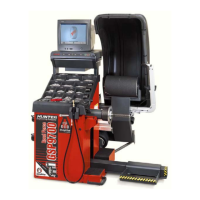68 4. Balancing a Wheel GSP9700 Series Road Force Measurement System Operation
QuickMatch™ Using Previous Bare Rim Measurement
If bare rim measurements (refer to “Rim Runout Measurement (Bare Rim),” page 56)
have been taken and will be used for QuickMatch™ procedures, it will be necessary
to scribe two aligning marks with a marker or chalk on the hub/shaft assembly and
the rim. This will allow you to align the rim and hub/shaft assembly back together
after mounting the tire on the rim. After spinning with the tire mounted and the load
roller enabled, press “Apply Last Rim Data” from “Current QuickMatch
Measurements” primary screen. This will recall the bare rim runout data from the
previous rim measurement.
QuickMatch™ Using Previous Loaded Runout Measurement
This procedure should be used if a bare rim measurement will be taken for rim
runout data after the Loaded Runout Measurement has been obtained, such
as when the rim runout data cannot be measured from the outside surface of
the rim.
With chalk or a marker, draw two aligning marks on the hub/shaft assembly
and the rim.
Mark the tire at the location of the valve stem and label the line “VS.”
Remove the assembly from the balancer.
Remove the tire from the rim and remount the bare rim onto the balancer,
being careful to realign the rim and hub/shaft assembly marks.
Take the bare rim measurement. Refer to “Rim Runout Measurement (Bare
Rim),” page 56.
Press “Apply Last Tire Data” to recall the previous Loaded runout
Measurement.
Mark the rim at the high spot of tire loaded runout and label the mark “TR.”
Mark the rim at the low spot of rim runout and label the mark “RR.”
Lay the tire down on the floor.
Remove the rim from the balancer and set it on top of the tire with the valve
stem (“VS”) mark on the tire aligned to the valve stem.
With the valve stem and valve stem (“VS”) mark aligned, transfer the loaded
runout (“TR”) mark from the rim to the tire and label it “TR.”
Mount the tire on the rim with the loaded runout (“TR”) mark on the tire and rim
runout (“RR”) mark on the rim aligned.
Dial Indicator Gauges Feature
The “Show Dial Indicators” key may be selected from the “Current QuickMatch
Measurements” screen to display on-screen dial indicator gauges. Each gauge
displays the runout (actual arm movement) encountered at that location. This data is
also displayed as the total indicated reading (T.I.R.) data on the runout plot screens.
Refer to “Harmonics & T.I.R. Data/Plots,” page 98. If there is green only showing in
the span of the gauge, T.I.R. runout is acceptable. If green and yellow appear on the
span of the gauge, T.I.R. runout is marginal. If red appears on the span of the gauge,
T.I.R. runout has been exceeded. The dial indicator located directly above the tire
tread is the loaded runout of the assembly as taken by the load roller.

